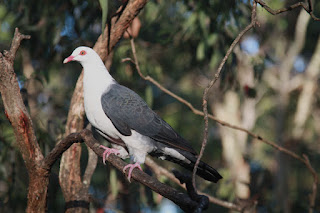My brother Brendan has sent me some photos of some interesting birds he has seen recently. These were not taken in Robertson, although the White-headed Pigeon is a seasonal visitor here.
The first are some Sooty Oystercatchers, which Brendan photographed at Gerroa, NSW (south from Kiama, and north from the wonderful Seven Mile Beach) on 17 December 2011.
It is not hard to work out how these birds get their name.
They are dusky coloured,
and they pick their way around rocky shelves
looking for juicy inter-tidal snacks to eat (not necessarily oysters).
 |
| Sooty Oystercatchers (courtesy B. Wilson) |
 |
| Sooty Oystercatchers (courtesy B. Wilson) |
 |
| Sooty Oystercatchers (courtesy B. Wilson) |
Here is the best image Brendan took, cropped a bit, to show its details.
 |
| Sooty Oystercatcher - a portrait (courtesy B. Wilson) |
Lawrence Finn, Brendan's son-in-law, took some photos of White-headed Pigeons when visiting at Dalmeny recently. Here are the images he captured (reduced to make them web-friendly). As mentioned in the introduction, these Pigeons are seasonal visitors to Robertson, but these photos were taken on the Far South Coast of NSW.
 |
| White-headed Pigeon (courtesy L. Finn) |
This is a magnificent male bird, in fine condition.
 |
| White-headed Pigeon (courtesy L. Finn) |
Male White-headed Pigeon.
Females have a duller cap,
and greyer (not shiny white) breast feathers.
and greyer (not shiny white) breast feathers.
 |
| White-headed Pigeon (courtesy L. Finn) |
Thanks to Brendan and Lawrence for the use of these images.

8 comments:
Good post Denis. I've seen White-headed Pigeons up this way, but only in winter, and only for a month or two. I've wondered where they went at other times, and what food they were chasing. I just presumed they went north (no reason behind it though).
I love pigeons, I wish we had some here (Armidale NSW), but I have only ever seen crested pigeons once in our forest just outside of Armidale.
Keith.
http://woodsrunnersdiary.blogspot.com
Hi Mark
I have a book on Pigeons and Doves by HJ Frith (former Head of CSIRO Wildlife Division), who made a personal study of Pigeons.
He reports that their seasonal movements are mostly into and out of Rainforest patches (which probably accounts for our both noticing them come and go).
It may not be an actual movement as such, but more a change in behaviour and local distribution.
The other thing he talks about is their feeding, being known to favour fruit of the introduced weedy-tree, Camphor Laurel. So much so that campaigns to eradicate that tree (best of luck with that!) in the Northern Rivers district of NSW are thought to have reduced the numbers of this species (by reducing their favourite food availability).
A case of a bad weed being promoted by a good Pigeon, perhaps.
.
For other readers, Mark Young's Birding Blog
has excellent photos of Sooty Oystercatchers as he frequently visits Long Reef.
He also sees White-headed Pigeons on occasions. Both are recorded in his Blog.
.
Cheers
Denis
Hi Keith
Yes, I recall a similar comment from you a while back.
These fruit-eating Pigeons must be just to the east from you, in the wetter forests.
Dorrigo, etc.
Grain and seed eaters, such as Bronzewing Pigeons ought be in the drier forests, but they do not like people very much. They behave like a typical "game bird" - stay out of sight, then flush with a whirring sound of wings as they depart.
Around my area, Crested Pigeons come into the village, and readily come to "bird feeders".
But we are on a railway line where grain is carried to the Ethanol Factory near Nowra, and that brings the Crested Pigeons to follow the trail of spilled grain along the railway line.
cheers
Denis
In 2003 we were in the UK. Early one morning I walked along the foreshore at Gosport near Portsmouth. The tide (9 m) was out so there were vast mud flats.
I heard a call but could not see the birds. I decided that if I was in Australia I would say Oystercatcher. But I could not get a sighting to confirm it.
On the way back half an hour later I got to see the bird and sure enough . . . . .
Their Oystercatcher is pied and from memory has much larger orange eye surrounds but even the call is very similar. Amazing.
Brendan
Universal distribution in many waders.
Ours are not nomadic, so they have diversified into separate species, but obviously they are still "recognisably close".
Thanks for the comment.
Denis
We have white-heded pigeons wandering around the backyard lately - it's the season in northern NSW. Also emerald doves. The sooty oyster-catchers and pied oyster-catchers are very common on the coast near me. It's interesting to read when my common birds are not so common for someone else.
Hi Joy.
I remember banding the Emerald Dove (it was known as the Green-winged Pigeon back then - that's how old the memory is) at Dalmeny, near where my brother now lives.
Lovely bird, lovely memory - thanks.
.
One of the things I like about sharing our sightings is just that point you have highlighted.
We all get different birds, plants and insects, and animals.
But within Australia they are not so "foreign" we can all relate to the sightings.
Cheers
Denis
Post a Comment